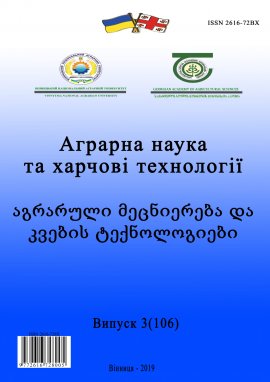
Issue №: 3(106)
У збірнику висвітлено питання підвищення продуктивності виробництва продукції сільського і рибного господарства, технології виробництва і переробки продукції тваринництва, харчових технологій та інженерії, водних біоресурсів і аквакультури.
INFLUENCE OF CALVING PERIOD ON THE CHARACTER OF LACTATION CURVE IN THE COWS OF DAIRY BREEDS
About journal
Аnimal feeding and feed technology; current problems of animal breeding, breeding and hygiene; food safety and food processing technology; aquatic bioresources and aquaculture
Certificate of state registration of the print media: КВ № 21523-11423Р 18.08.2015
Founder of the collection: Vinnytsia National Agrarian University, Georgia Academy of Agricultural Sciences
Editor-in-Chief: Viktor Mazur, Candidate of Agricultural Sciences Associate Professor, VNAU (Vinnytsia)
Deputy editors-in-chief: Aleksidze G.M., D.Sc.(Ph.D.), academician of the Academy of agricultural sciences of Georgia; Yaremchuk O.S., D.Sc.(Ph.D.) Professor, University of Vinnitsa (Vinnytsia)
Secretary in charge: L. Kazmiruk
Editorial Board full list
Editorial board
Mazur Viktor, Candidate of Science, Associate Professor of VNAU (Editor-in-Chief);
Guram Aleksidze, Ph.D., Academician of the Academy of Agricultural Sciences Georgia (Deputy Editor-in-Chief);
Yaremchuk Oleksandr, Ph.D., Professor, VNAU (Deputy Editor-in-Chief);
Members of the Editorial Board:
Ibatullin Ildus, Ph.D., Professor, Academician, NULES;
Kaletnik Hryhoriy Ph.D. (Economics), Academician of NAAS of Ukraine, VNAU;
Zakharenko Mykola Oleksandrovych, Ph.D., Professor, NULES;
Vashakidze Archil, Ph.D., Academician, National Coordinator for Agricultural Electrification and Automation (Georgia);
Giorgadze Anatoly, Ph.D. (Engineering), Academy of Agricultural Sciences of Georgia;
Grib Josip, Ph.D, Professor of NUHPP;
Dzhaparidze Givi, Ph.D. (Economics), Academician, Vice-President of the Academy of Agricultural Sciences science of Georgia;
Georgiy Yeresko, Ph.D. (Engineering), Professor, Corresponding Member of NAAS of Ukraine, Institute of Food Resources;
Vlasenko Volodymyr, Ph.D.(Engineering), Professor of VTEI;
Kulyk Mykhaylo, Ph.D., Professor, Corresponding Member of NAAS of Ukraine, VNAU;
Kucheriaviy Vitaliy, Ph.D.(Engineering), Professor, VNAU;
Lysenko Alexander, Ph.D., Professor, Research Institute of Experimental Veterinary Science, Academy of Sciences of Belarus (Minsk);
Lyotka Halyna, Ph.D., Associate Professor of VNAU;
Mazurenko Mykola, Ph.D., (Engineering), Professor;
Polishchuk Galina, Ph.D., Associate Professor;
Sychevsky Mykola, Ph.D.(Economics), Professor, Corresponding Member of the National Academy of Sciences of Ukraine, Institute of Food Resources;
Skoromna Oksana, Ph.D., Associate Professor;
Chagelishvili Revaz, Ph.D., Academician, National Forestry Coordinator (Georgia);
Chudak Roman, Ph.D., (Engineering), Professor, VNAU;
Sheiko Ivan, Doctor of Science, Professor, Institute of Animal Science of the Academy of Sciences of Belarus (Zhodino);
Kazmyruk Larisa, Ph.D., Associate Professor of VNAU (secretary in charge).
Edition: Collection
Type of publication for the intended purpose: scientific
Edition status: shared
Year of foundation: 2015
Frequency: 1 to 5 times a year
Volume: 4 to 10 ppm (format A-4)
Edition language: (different languages) Ukrainian, Georgian, English, Russian
Scope and category of readers: nationwide, foreign researchers, university professors, graduate students, students and professionals of agriculture and fisheries and food production
Article publishing is a paid service. Cost for printing in professional publications in accordance with the Decree of the Cabinet of Ministers of Ukraine of August 27, 2010 No. 796 "On approval of the list of paid services that can be provided by state educational institutions, other institutions of educational system belonging to state and communal ownership" and the Rector Order of the Higher Education University Mazur V.A. dated March 14, 2018 No. 93 “On setting the cost of printing in professional editions of the University”.
The cost of printing one page in professional editions of the university is 60 UAH.
Beneficiary: Vinnytsia National Agrarian University MFO 820172 Current account No. 31256282102055 code 00497236 Bank State Treasury Service of Ukraine, Kyiv. VAT payer code 004972302286. Registration number 100271744. Purpose of payment: for printing an article in the collection: "Agrarian science and food technology".
Agrarian Science and Food Technology Established in 1994 under the name of the Collection of Scientific Works of VSAU.
According to the Resolution of the Presidium of the Higher Attestation Commission of Ukraine of September 11, 1997, this publication has acquired the status of a professional, in which it is allowed to publish the main results of the dissertation research in the fields of "Agronomy", "Animal engineering" and "Economic Sciences".
In 2001-2014 it was published under the title "Collection of scientific works of Vinnytsia National Agrarian University".
Since 2015 it is:"Agricultural Science and Food Technologies".
Listed in the updated list of scientific professional editions of Ukraine in agricultural sciences under the name "Agrarian Science and Food Technologies" (ground: Order of the Ministry of Education and Science of Ukraine of May 16, 2016 No. 515).


